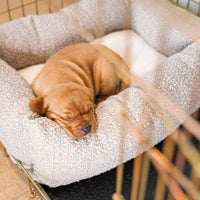Getting your puppy, or even your adult dog, to sleep alone at night is a crucial milestone in their training. Whether you've just welcomed a new furry family member or are struggling with an existing canine companion who insists on sleeping in your bed, this guide will provide you with expert tips and techniques to teach your pet to sleep independently. Say goodbye to sleepless nights and hello to a well-rested, happy pup.
Start Early: Puppy Sleep Training
If you have a puppy, it's essential to establish good sleep habits from the beginning. Puppies, like babies, need structure and routine. Start by creating a designated sleeping area for your puppy, preferably in a quiet and dark part of your home. Use a comfortable crate or a cosy dog bed to make them feel secure.
Crate Training

Crate training is a highly effective method to teach your puppy or dog to sleep alone. Dogs have a natural denning instinct, and a crate mimics this instinct, providing a safe and secure space for your pet. Here's how to use crate training for better sleep:
- Introduce the crate gradually: Let your pup explore the crate with positive associations, such as treats and toys.
- Create a comfortable space: Add soft bedding and a favourite toy to make the crate inviting. Our crate sets are great for creating a cosy den, we've written a guide with everything you need to know about setting up your dog or puppies dream crate.
- Gradual confinement: Begin with short intervals and gradually increase the time your pup spends in the crate. We recommend using positive reinforcement training methods, every time your pup goes in their crate give them a treat and some praise so they being to associate the crate as being a positive space.
- Consistency: Maintain a consistent bedtime routine, putting your pup in the crate at the same time each night.
- Avoid punishment: Never use the crate as a form of punishment. It should always be a positive and safe space.
Positive Reinforcement
Reward-based training is a powerful tool in teaching your dog to sleep alone. Use treats, praise, and affection to reinforce good behavior. Here's how to apply positive reinforcement:
- Bedtime treats: Give your pup a special treat or toy that they only get at bedtime.
- Praise calm behaviour: Whenever your dog settles down in their designated sleeping area, offer praise and affection.
- Ignore whining: If your pup whines or cries, wait for a moment of quiet, then reward them with attention.
Gradual Transition

For dogs accustomed to sleeping in your bed, transitioning them to sleep alone can take time. Make the change gradually by following these steps:
- Start with the crate: Begin by having your dog sleep in their crate beside your bed.
- Move the crate: Gradually move the crate farther from your bed over several nights.
- Encourage independence: Eventually, your dog should be comfortable sleeping alone in their crate or designated sleeping area.
Exercise and Mental Stimulation
A tired dog is more likely to sleep soundly through the night. Ensure your pup gets plenty of exercise and mental stimulation during the day. A tired dog is less likely to be restless at night, making the transition to sleeping alone smoother.
Interactive puzzle toys are great for wearing your dog's mind out before bed, we love the Nina Ottosson toys for this!
Consistency Is Key

Consistency is the cornerstone of successful dog training. Stick to a routine and reinforce positive behaviour consistently. Dogs thrive on predictability, and a consistent sleep routine will help them feel secure and comfortable in their sleeping space.
Training your dog or puppy to sleep alone is a process that requires patience, consistency, and positive reinforcement. By following these expert tips and techniques, you can help your canine companion develop good sleep habits, ensuring both you and your furry friend enjoy peaceful nights.
Remember, every dog is unique, so tailor your approach to suit your pet's individual needs. With time and dedication, you'll have a well-rested and contented pup who sleeps soundly on their own.
































































































